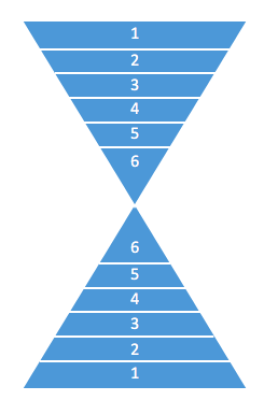
Be aware: this is only the goal of this diet, not necessarily its outcome. Results vary from person to person. Consult your doctor or dietician before starting this (or any other) diet.
The Nutrition hourglass was devised by Kris Verburgh and is also known as the hourglass diet. The concept is not so much presented as a diet, but more as an alternative to the ‘Disk of five’ guideline from the Dutch Nutrition Centre.
The aim of the concept is to live a longer and healthier life with the help of the nutrition hourglass. A consequence of eating according to the hourglass can be that you lose weight.
The advice here is to eat less sugars and not to overeat on (animal) protein. As an alternative to products with lots of sugars and (animal) protein, several products are mentioned in the nutrition hourglass.
It is recommended to consume healthier fats, for instance by eating oily fish. Furthermore, sufficient fibre, minerals and vitamins should be consumed. Additionally, supplements are part of this diet.
Notably, the Nutrition hourglass usually does not specify how much of something you should eat or drink.
The book states three principles: consume fewer carbohydrates (1), don’t overeat (animal) protein (2) and consume enough healthy fats (3).
The hourglass has six steps. Each step is repeated twice: at the top and at the bottom, as can be seen in the picture below.

Every layer has examples of products that are not recommended (in the book they are shown in the top part of the hourglass) and examples of products that can be chosen as replacements (there are shown in the bottom part of the hourglass in the book). Below a description of each layer.
The top part of the hourglass, the first layer, lists drinks that should be consumed less. These include soft drinks, milk, pre-packaged juices and (drinking) yoghurt. Instead of these drinks, you can choose the drinks from layer 1 at the bottom of the hourglass (in the book): water, fresh fruit juice, green tea, white tea, ginger tea, red wine and plant-based milk.
In the second layer, products containing (relatively) many carbohydrates are discouraged. Products like bread, pasta, rice and potatoes should be eaten less. Instead, vegetables, fruits, legumes, mushrooms and oatmeal are advised.
The book recommends eating about 300 grams of vegetables per day. It is also recommended to eat products with a glycemic index (GI) value of less than 50. More information about the glycemic index can be found on the pages of the GI diet, Low GI diet, Montignac diet and Slow Carb diet.
In layer 3, fast food, fried food and red meat are discouraged. Instead of these products, fatty fish (for instance mackerel and herring), cheese, tofu, quorn, egg and poultry (chicken and turkey) are recommended.
The fourth layer concerns snacks. Products such as biscuits, sweets and ice cream should be eaten less. Alternatives include dark chocolate, nuts and soya products (soya porridge or soya yoghurt).
The fifth layer is the last one concerning foods or drinks. In this layer, it is recommended to consume less margarine, butter, sauce, salt and sugar. Instead, sugar substitutes, healthy oils and 'healthy' flavour enhancers should be used.
The sixth and last layer concerns medicines and supplements. Here, medicines are in the 'less' step and supplements in the 'more' step. Supplements mentioned are, for instance, vitamin D, iodine, magnesium, selenium and various types of vitamin B.
Please note: do not just start taking less medication without consulting a doctor.
It is important to mention that the book makes a number of claims about, among other things, growing old (in a healthy way), appearance and diabetes, about which various discussions have taken place. These claims will not be discussed further here.
Consult your doctor or dietician before starting this (or any) diet.
To read more about the nutrition hourglass, you can buy the Dutch book 'De Voedselzandloper'. There is also a cookbook available.
Besides these Dutch books, Kris Verburgh also wrote ‘The Longevity Code’.
The Nutrition hourglass is presented as an alternative to the disc of five. It also uses the glycemic index. Other diets that use this index are: the GI diet, Low GI diet, Montignac diet and Slow Carb diet.
As you see fit
With the professional help of a dietitian it should be easier to reach your goals. Please contact a dietician in your area or talk to a doctor before starting any diet.
Please take note that most diets do not have a scientific basis.
Consult your doctor or dietician before starting a diet, especially if you have a chronic condition like diabetes, cardiovascular disease, lung disease or kidney disease.
If you think you might have an eating disorder (like anorexia or bulimia), it is important to look for professional help. Contact your (house) doctor or find help elsewhere. Here you can find a list of several websites that can provide (online) help. These sites also provide information for people that know someone with an eating disorder.